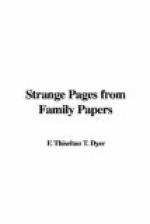It has been denied, however, that Father Arrowsmith was hanged for “witnessing a good confession,” and Mr. Roby, in his “Traditions of Lancashire,” says that, having been found guilty of a rape, in all probability this story of his martyrdom, and of the miraculous attestation to the truth of the cause for which he suffered, were contrived for the purpose of preventing the scandal that would have come upon the Church through the delinquency of an unworthy member. It is further said that one of the family of the Kenyons attended as under-sheriff at the execution, and that he refused the culprit some trifling favour at the gallows, whereupon Arrowsmith denounced a curse upon him, to wit, that, whilst the family could boast of an heir, so long they never should want a cripple—a prediction which was supposed by the credulous to have been literally fulfilled. But this story is discredited, the real facts of the case, no doubt, being that he was hanged “under sanction of an atrocious law, for no other reason but because he had taken orders as a Roman Catholic priest, and had endeavoured to prevail upon others to be of his own faith.” According to another version of the story, Edmund Arrowsmith was a native of Haydock, in the parish of Winwick. He entered the Roman Catholic College of Douay, where he was educated, afterwards being ordained priest. But in the year 1628 he was apprehended and brought to Lancaster on the charge of being a priest contrary to the laws of the realm, and was executed on 26th August, 1628, his last words being “Bone Jesu."[33] As recently as the year 1736, a boy of twelve years, the son of Caryl Hawarden, of Appleton-within-Widnes, county of Lancaster, is stated to have been cured of what appeared to be a fatal malady by the application of Father Arrowsmith’s hand, which was effected in the following manner: The boy had been ill fifteen months, and was at length deprived of the use of his limbs, with loss of his memory and impaired sight. In this condition, which the physicians had declared hopeless, it was suggested to his parents that, as wonderful cures had been effected by the hand of “the martyred saint,” it was advisable to try its effects upon their afflicted child. The “holy hand” was accordingly procured from Bryn, packed in a box and wrapped in linen. Mrs. Hawarden, having explained to the invalid boy her hopes and intentions, applied the back part of the dead hand to his back, stroking it down each side the backbone and making the sign of the Cross, which she accompanied with a fervent prayer that Jesus Christ would aid it with His blessing. Having twice repeated this operation, the patient, who had before been utterly helpless, rose from his seat and walked about the house, to the surprise of seven persons who had witnessed the miracle. From that day the boy’s pains left him, his memory was restored, and his health became re-established. This mystic hand, it seems, was removed from Bryn Hall to Garswood, a seat of the Gerard family, and subsequently to the priest’s house at Ashton-in-Makerfield. But many ludicrous tales are current in the neighbourhood, of pilgrims having been rather roughly handled by some of the servants, such as getting a good beating with a wooden hand, so that the patients rapidly retraced their steps without having had the application of the “holy hand.”




